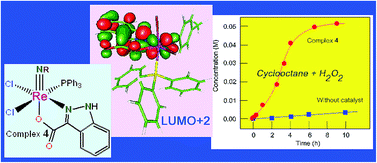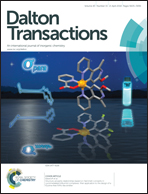New p-tolylimido rhenium(v) complexes with carboxylate-based ligands: synthesis, structures and their catalytic potential in oxidations with peroxides†
Abstract
Novel p-tolylimido rhenium(V) complexes trans-(Cl,Cl)-[Re(p-NC6H4CH3)Cl2(pyz-2-COO)(PPh3)]·MeCN (1), trans-(Cl,Cl)-[Re(p-NC6H4CH3)Cl2(pyz-2-COO)(PPh3)] (2), trans-(Br,Br)-[Re(p-NC6H4CH3)Br2(pyz-2-COO)(PPh3)] (3), cis-(Cl,Cl)-[Re(p-NC6H4CH3)Cl2(ind-3-COO)(PPh3)]·2MeOH (4), 2[Re(p-NC6H4CH3)Cl2(ind-3-COO)(PPh3)]·MeCN (5), 2[Re(p-NC6H4CH3)Br2(ind-3-COO)(PPh3)]·MeOH (6) and 2[Re(p-NC6H4CH3)Br2(ind-3-COO)(PPh3)]·MeCN (7) were obtained in the reactions of [Re(p-NC6H4CH3)X3(PPh3)2] (X = Cl, Br) with pyrazine-2-carboxylic (pyz-2-COOH or PCA) and indazole-3-carboxylic (ind-3-COOH) acids. The compounds were identified by elemental analysis, IR, 1H, 13C and 31P NMR spectroscopy and X-ray crystallography. To get a deeper understanding of the structural and bonding properties of the imido rhenium(V) complexes, calculations at the DFT level were undertaken for trans-(Cl,Cl)-[Re(p-NC6H4CH3)Cl2(pyz-2-COO)(PPh3)] and cis-(Cl,Cl)-[Re(p-NC6H4CH3)Cl2(ind-3-COO)(PPh3)]. Complexes 1, 3, 4 and 6 exhibited high catalytic activity in oxidation of alkanes with H2O2 and tert-butyl hydroperoxide (TBHP) and of alcohols with TBHP. The selectivity parameters measured in the reactions with linear and branched alkanes indicated that the processes with H2O2 or TBHP proceed with the participation of hydroxyl or tert-butoxyl radicals, respectively. The composition of isomers from oxygenation of methylcyclohexane corresponds to the existence of some steric hindrance around the reaction centers.


 Please wait while we load your content...
Please wait while we load your content...